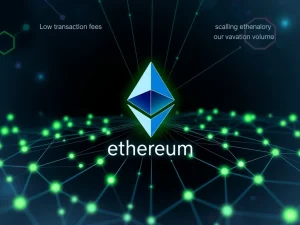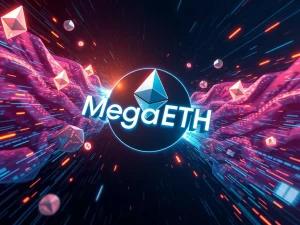Ethereum Foundation Unveils Groundbreaking Platform to Accelerate Wall Street Ethereum Integration

The digital asset landscape is rapidly evolving, marking a pivotal moment for traditional finance. The Ethereum Foundation recently unveiled a groundbreaking initiative: institutions.ethereum.org. This new website is specifically designed to bridge the gap between Wall Street Ethereum operations and the broader blockchain ecosystem. This strategic move signals a clear intent to accelerate institutional engagement with the world’s leading smart contract platform.
Ethereum Foundation’s Strategic Move for Institutional Onboarding
The Ethereum Foundation has launched a dedicated online resource. It aims to onboard more institutions efficiently. This platform provides clear pathways for businesses. They can move from traditional finance (TradFi) into the Ethereum ecosystem. The Foundation announced “institutions.ethereum.org” via an X post on Wednesday. Their Enterprise Acceleration team developed the site. It showcases the network’s capabilities. It also guides businesses adopting Ethereum.
The X post stated, “Ethereum is the neutral, secure base layer. The world’s financial value is coming onchain here. Today, we’re launching a new site for the builders, leaders, and institutions. They are advancing this global movement.” This new resource highlights Ethereum’s robust infrastructure. It aims to demystify blockchain adoption for large-scale entities. Consequently, it simplifies the complex transition from conventional financial systems to decentralized ones. This initiative directly addresses the fragmentation and lack of clear entry points that often deter large financial players. The Ethereum Foundation acts as a neutral facilitator, providing a unified, authoritative source of information and guidance.
Institutions often face significant hurdles when considering blockchain integration. These include regulatory uncertainty, technical complexity, and a perceived lack of enterprise-grade solutions. This new website directly confronts these challenges. It offers a streamlined approach. Businesses can now easily access relevant information. They can explore validated use cases. Furthermore, they can understand the practical steps involved in integrating with Ethereum. This proactive engagement underscores the Foundation’s commitment to fostering a symbiotic relationship between TradFi and the decentralized world.
Unlocking the Potential of Tokenized Assets and Real-World Value
The new website features a simplistic, intuitive design. It clearly showcases numerous institutional use cases. These include tokenized assets, specifically Real World Assets (RWAs). It also highlights stablecoins, decentralized finance (DeFi) applications, and advanced privacy tools. Furthermore, it emphasizes the role of Layer 2 networks in enhancing scalability. The platform provides direct links to crucial on-chain data. This data confirms Ethereum’s dominance in various sectors.
For instance, Ethereum currently hosts 75% of the RWA market share. It also secures 65% of all DeFi Total Value Locked (TVL). Additionally, 60% of all stablecoin TVL resides on Ethereum. These figures underscore its position as a preferred network. The site offers a clear view of how real-world value can transition onto the blockchain. It explains how digital representations of physical assets can create new financial opportunities. Tokenization brings several key benefits for institutions:
- Fractional Ownership: Allowing smaller investments in high-value assets.
- Increased Liquidity: Making illiquid assets more tradable.
- Faster Settlement: Reducing transaction times from days to minutes.
- Global Accessibility: Broadening investor bases beyond geographical limits.
- Enhanced Transparency: Providing immutable records of ownership and transfers.
- Reduced Intermediaries: Streamlining processes and lowering costs.
Stablecoins, for their part, serve as a critical bridge. They link the volatile crypto market with traditional fiat currencies. For institutions, stablecoins are essential for treasury management. They facilitate cross-border payments. They also mitigate price volatility, offering a stable medium of exchange within the blockchain ecosystem. Layer 2 networks, such as Optimism, Arbitrum, and Coinbase’s Base, further enhance Ethereum’s appeal. They provide solutions for scalability and lower transaction costs. This makes high-volume enterprise transactions feasible and economically viable.
Major Players Driving DeFi Adoption on Ethereum
The platform proudly spotlights major institutions already leveraging the network. It provides key examples of their work. This data is verifiable via on-chain records. For example, Visa processes an annual $1 billion in stablecoin volume on Ethereum. BlackRock manages $1.15 billion worth of tokenized assets. Coinbase’s Layer 2 solution, Base, boasts $15.5 billion in TVL. These examples demonstrate tangible, large-scale DeFi adoption.
These collaborations validate Ethereum’s enterprise-grade readiness. They also show its capacity to handle significant financial operations. The website serves as a testament to these successes. It inspires other institutions to explore similar integrations. Ultimately, it aims to foster a more interconnected financial future. Visa’s stablecoin program, for instance, utilizes Ethereum for its treasury operations. It facilitates cross-border settlements with greater efficiency and transparency than traditional methods. This partnership showcases how a global payments giant can leverage decentralized technology for core business functions.
BlackRock, the world’s largest asset manager, launched its tokenized asset fund, BUIDL, on Ethereum. This move represents a monumental endorsement of blockchain technology. It validates the potential for institutional-grade financial products on-chain. BUIDL demonstrates the increasing convergence of traditional asset management with digital innovation. Furthermore, Coinbase’s Base, an Ethereum Layer 2, offers a secure and scalable environment for developers and businesses. Its substantial Total Value Locked (TVL) indicates robust activity. It highlights the growing ecosystem built to serve institutional and retail users alike.
Navigating the Future for Ethereum Institutions: Education and Resources
The institutions.ethereum.org site is structured logically. It includes three main sections for easy navigation. The “Digital Assets” section provides an overview of various blockchain sectors. It clarifies concepts like tokenization and DeFi. A “Live Data” section offers real-time insights into network activity. Finally, a “Library” offers “Institutional Insights.” This library compiles research reports, news articles, and other valuable resources. These resources aid in informed decision-making for Ethereum institutions.
This comprehensive resource addresses a previously identified gap. Earlier this year, Ethereum Foundation-backed Etherealize launched. It aimed to improve institutional education about Ethereum. The new website builds upon this foundation. It offers a centralized hub for knowledge and practical guidance. It simplifies the learning curve for new entrants. The sections include:
- Digital Assets: Explains key blockchain sectors, demystifying complex concepts.
- Live Data: Provides transparent, verifiable on-chain metrics crucial for institutional due diligence.
- Library: Offers curated research, news, and case studies to inform strategic decisions.
Such educational initiatives are paramount. They empower institutions to navigate the evolving regulatory landscape. They also help understand best practices for secure and compliant blockchain integration. By providing a single source of truth, the Ethereum Foundation fosters greater confidence. It encourages responsible innovation within the institutional sector. This commitment to education ensures that new entrants are well-equipped to leverage Ethereum’s capabilities effectively.
Beyond the Website: Advancing Wall Street Ethereum Integration
The launch of this website marks another significant push. The Ethereum Foundation actively markets the blockchain’s capabilities. This effort aligns with recent strategic improvements. For instance, the Foundation released a new roadmap in mid-September. This roadmap outlines plans for introducing end-to-end privacy features. It forms part of a rebranding initiative. “Privacy and Scaling Explorations” is now “Privacy Stewards of Ethereum.” This commitment to privacy is crucial for institutional confidence.
Privacy is a paramount concern for institutions. It addresses data confidentiality, regulatory compliance, and competitive advantage. The “Privacy Stewards of Ethereum” initiative aims to integrate robust privacy solutions directly into the network. This ensures that sensitive institutional data remains secure. It also allows for selective disclosure when required for regulatory purposes. Such features are indispensable for attracting and retaining large financial entities. They provide the necessary assurances for handling proprietary information on a public blockchain.
During the same month, the Foundation unveiled a new AI-focused research team. Its goal is developing a strong AI economy. This includes autonomous agents and bots on Ethereum. It also aims to provide a decentralized AI stack for developers. Davide Crapis, an Ethereum Foundation research scientist, stated via X, “Our mission: make Ethereum the preferred settlement and coordination layer for AIs and the machine economy.” This forward-looking vision positions Ethereum as a foundational layer for future technologies, further solidifying its appeal for Wall Street Ethereum integration.
The convergence of AI and blockchain on Ethereum presents immense opportunities. AI agents could automate complex financial processes. They could enhance risk management. They might also facilitate new forms of decentralized autonomous organizations (DAOs). This proactive research ensures Ethereum remains at the cutting edge of technological innovation. It guarantees its relevance for the future of finance and beyond. These developments demonstrate a holistic strategy. It extends far beyond simple digital asset transfers. It encompasses the entire future of digital value and interaction.
The introduction of institutions.ethereum.org represents a monumental step. It strengthens the bridge between traditional finance and the decentralized world. By offering clear guidance, showcasing robust data, and highlighting successful institutional use cases, the Ethereum Foundation is actively courting large-scale adoption. This initiative, coupled with ongoing developments in privacy and AI, reinforces Ethereum’s position. It stands as the leading blockchain for enterprise-grade solutions. This proactive approach ensures Ethereum remains at the forefront of financial innovation. It invites global institutions to participate in shaping the future of finance.










